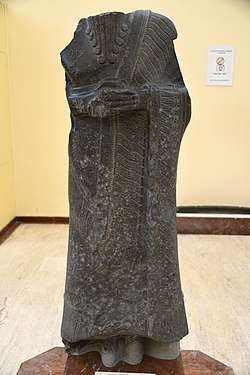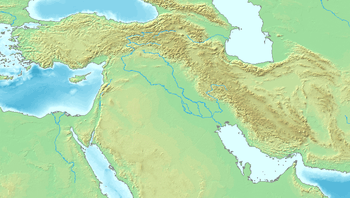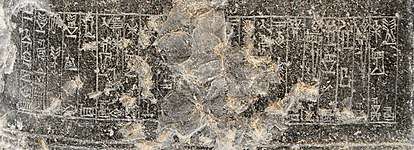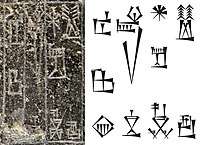Tura-Dagan
Tura-Dagan (𒌅𒊏𒀭𒁕𒃶, Tu-ra-Dda-gan, c. 2075–2050 BCE) was a ruler of the city of Mari, northern Mesopotamia, after the fall of the Akkadian Empire. He was son of Apil-Kin, and brother of Ili-Ishar.[2] He held the title of Shakkanakku (military governor), which was borne by all the princes of a dynasty who reigned at Mari in the late third millennium and early second millennium BC. These kings were the descendants of the military governors appointed by the kings of Akkad.[3] He was contemporary of the Third Dynasty of Ur, and probably their vassal.[4]
| Tura-Dagan 𒌅𒊏𒀭𒁕𒃶 | |
|---|---|
| Military governor of Mari | |
 Statue of Tura-Dagan, Shakkanakku of Mari. Originally from Mari (c. 2071–2051 BCE). Museum of the Ancient Orient, Istanbul.[1] | |
| Reign | c.2075–2050 BCE |
| Predecessor | Ili-Ishar |
| Successor | Puzur-Ishtar (son) |
| Dynasty | Shakkanakku dynasty |

He had a son, who succeeded him, named Puzur-Ishtar.
Inscriptions
The Museum of the Ancient Orient has a statue of Tura-Dagan, but it is headless and the inscription is heavily damaged.[5] Tura-Dagan is also known from various seals and dynastic lists.[2]
A statue of Puzur-Ishtar is known from the Royal Palace of Mari, now in the Museum of the Ancient Orient in Istanbul, with an inscription on the hem of the statue’s skirt mentioning his father Tura-Dagan.[6][7]
The inscription on the hem of the statue reads:
"Tura-Dagan, prince of the country of Mari, Puzur-Ishtar, the prince, his son, to god [...], lord [...], god [....], for their life, (have offered this statue). For the one who deletes this dedication, may gods Ninni, Dagan and Enki, master of [...], tear down his foundation and destroy his progeny together with his territory"
— Puzur-Ishtar inscription (hem).[8]
 Puzur-Ishtar statue inscription (hem).[8]
Puzur-Ishtar statue inscription (hem).[8]

"Tura-Dagan Governor of Mari"
𒌅𒊏𒀭𒁕𒃶 𒄊𒀴 𒈠𒌷𒆠
Tura-Dagan Shakkanakku Mari-ki
on the Statue of Puzur-Ishtar, his son and successor.
Ancient Orient Museum, Istanbul.
Tura-Dagan of Mari | ||
| Regnal titles | ||
|---|---|---|
| Preceded by Ili-Ishar |
Shakkanakku of Mari c.2075–2050 BC |
Succeeded by Puzur-Ishtar |
References
- Per Museum of the Ancient Orient item notice
- Leick, Gwendolyn (2002). Who's Who in the Ancient Near East. Routledge. p. 168. ISBN 978-1-134-78796-8.
- Louvre. "The Statuette of Iddi-Ilum," Department of Near Eastern Antiquities: Mesopotamia. Accessed December 1, 2014. http://www.louvre.fr/en/oeuvre-notices/statuette-iddi-ilum
- Unger, Merrill F. (2014). Israel and the Aramaeans of Damascus: A Study in Archaeological Illumination of Bible History. Wipf and Stock Publishers. p. 5. ISBN 978-1-62564-606-4.
- Per Museum of the Ancient Orient item notice
- Gates, Henriette-Marie. "The Palace of Zimri-Lim at Mari." The Biblical Archaeologist 47 (June.,1984): 70-87.
- Gates, "The Palace of Zimri-Lim at Mari," 70-87.
- For transcript and translation: Nassouhi, Essad (1926). "Statue d'un dieu de Mari, vers 2225 av. J.-C". Archiv für Orientforschung. 3: 112–113. ISSN 0066-6440. JSTOR 41662864.